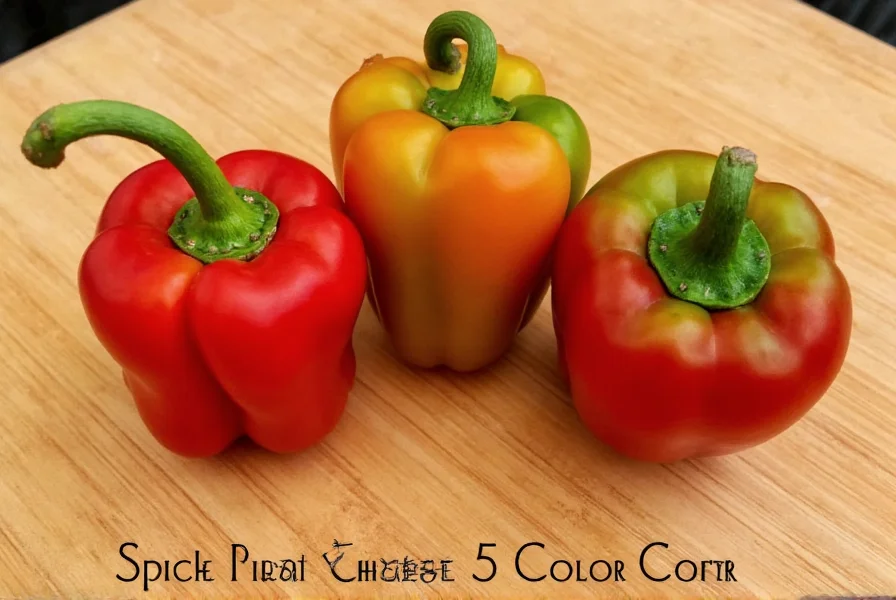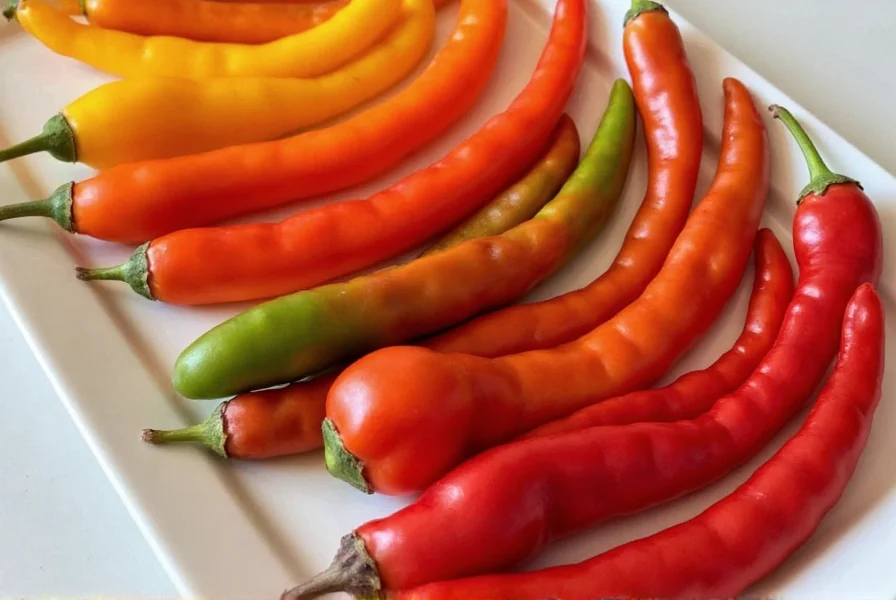Thai Chilies, commonly known as Bird's Eye Chilies, are small, potent peppers native to Southeast Asia. Despite the common misnomer "Chinese 5 Color Peppers," they are not from China and do not represent a specific "5 color" variety. Instead, these peppers naturally change color as they ripen, typically progressing from green to yellow, orange, and red. In this guide, we'll explore their true Scoville ratings, color variations, flavor profiles, and practical cooking applications for authentic Asian dishes. Whether you're adding heat to stir-fries or making homemade chili oil, Thai Chilies deliver exceptional flavor and versatility.
Discover how to select, store, and use these vibrant peppers to elevate your culinary creations. Let's dive in!
Table of Contents
- Introduction to Thai Chilies
- Decoding the Colors: What Each Pepper Means
- Understanding the Scoville Scale and Thai Chilies
- Flavor Profiles: Heat Meets Harmony
- Top 5 Cooking Tips Using Thai Chilies
- Buying Guide: Choosing the Best Thai Chilies
- Frequently Asked Questions About Thai Chilies
- Conclusion: Spice Up Your Life with Thai Chilies
Introduction to Thai Chilies
Thai Chilies (Capsicum annuum var. chinense) are small, slender peppers native to Thailand and widely cultivated across Southeast Asia. They are often mistakenly called "Chinese 5 Color Peppers" in some international markets, but this is a misnomer. These peppers are not Chinese in origin and do not have a standardized "five-color" classification. Instead, they naturally change color as they ripen, typically starting green and progressing through yellow, orange, and red. The color variation reflects ripeness stages, not distinct varieties.
Unlike many chilies harvested at a single stage, Thai Chilies are often picked at different ripeness levels, allowing chefs to use multiple colors in one dish for visual appeal and nuanced heat profiles. They are a staple in Thai, Vietnamese, and other Southeast Asian cuisines, prized for their intense flavor and versatility.
Decoding the Colors: What Each Pepper Means
Each color stage represents a different ripeness level, affecting flavor, aroma, and heat. Here's a detailed breakdown:
| Color | Flavor Profile | Heat Level (Approximate) | Best Use |
|---|---|---|---|
| Green | Fresh, grassy, slightly vegetal | 50,000–70,000 SHU | Stir-fries, fresh salsas, pickling |
| Yellow | Fruity, citrusy, bright | 60,000–80,000 SHU | Dipping sauces, marinades, tropical dishes |
| Orange | Sweet-tangy, balanced | 70,000–90,000 SHU | Rubs, roasted vegetables, Asian sauces |
| Red | Rich, smoky, complex | 80,000–100,000+ SHU | Chili oils, dried chili flakes, spicy pastes |
Understanding the Scoville Scale and Thai Chilies
The Scoville Scale measures chili pepper heat in Scoville Heat Units (SHU), developed by pharmacist Wilbur Scoville in 1912. Thai Chilies consistently rank between 50,000 and 100,000+ SHU, placing them in the "very hot" category. This makes them significantly hotter than jalapeños (2,500–8,000 SHU) but milder than habaneros (100,000–350,000 SHU).
Key comparisons:
- Bell pepper = 0 SHU
- Jalapeño = 2,500–8,000 SHU
- Serrano pepper = 10,000–23,000 SHU
- Thai Chili (Green) = 50,000–70,000 SHU
- Thai Chili (Red) = 80,000–100,000+ SHU
- Habanero = 100,000–350,000 SHU
Heat levels vary based on growing conditions, with drought stress increasing capsaicin production. The red varieties are typically the hottest due to full ripeness, while green peppers offer a brighter, more vegetal heat.
Flavor Profiles: Heat Meets Harmony
Thai Chilies are renowned for their complex flavor beyond just heat. Each color stage brings unique taste characteristics:
- Green Peppers: Crisp, herbaceous, with a sharp, clean heat — ideal for fresh applications like sambals, green curries, and uncooked garnishes.
- Yellow Peppers: Citrus-forward with tropical fruit notes — perfect for balancing sweet and sour dishes like Vietnamese dipping sauces or Thai fish sauce-based recipes.
- Orange Peppers: Balanced sweetness with mild acidity — excellent for roasting, grilling, or adding depth to stir-fries and marinades.
- Red Peppers: Deep, smoky, and intensely flavorful — the best choice for chili oils, dried chili flakes, and fermented pastes where concentrated heat is needed.
Top 5 Cooking Tips Using Thai Chilies
Ready to harness the power of Thai Chilies? Try these expert tips:
- Use Fresh in Authentic Asian Dishes: Dice green or yellow peppers for Thai green curry, Vietnamese pho, or Korean kimchi. Their bright heat cuts through rich fats beautifully.
- Dry Them for Homemade Chili Flakes: String whole peppers and dry in a cool, dark place. Once crisp, crush into flakes for a versatile seasoning that lasts months.
- Infuse Oils for Maximum Flavor: Simmer red peppers in neutral oil (like grapeseed) with garlic and star anise for 10 minutes. Strain and store for drizzling over noodles or dumplings.
- Add Whole Peppers to Stir-Fries: Toss whole (or halved) peppers into a wok for visual appeal and controlled heat. Remove before serving if you prefer milder dishes.
- Make Multi-Color Chili Paste: Blend green, yellow, and red peppers with fish sauce, lime juice, and palm sugar for a vibrant, complex paste that elevates any protein.
Buying Guide: Choosing the Best Thai Chilies
Whether shopping at Asian markets, specialty stores, or online, follow these guidelines:
What to Look For
- Vibrant, consistent colors: Avoid dull, wrinkled, or moldy peppers. Look for smooth, firm skin.
- Firm texture: Gently squeeze — peppers should feel solid, not soft or mushy.
- Minimal blemishes: Small scratches are normal; avoid peppers with dark spots or significant damage.
Storage Tips
- Refrigerate in a paper bag inside the crisper drawer for up to 1 week.
- Freeze whole peppers in a ziplock bag for up to 6 months (no thawing needed for cooking).
- Dry them using a dehydrator or oven on low heat for long-term storage.
Recommended Products
- Dried Thai Chilies (Organic, Pack of 5 oz)
Features: Organic, non-GMO, sun-dried
Advantages: Intense flavor, long shelf life
Best For: Making chili oil, spice blends, and marinades
Occasion: Home cooking, meal prep - Thai Chili Seeds (Non-GMO, 50+ Seeds)
Features: Heirloom seeds, easy-to-grow
Advantages: Grow your own supply, fun gardening project
Best For: Gardeners, foodies, homesteaders
Occasion: Spring planting season - Chili Pepper Infusion Kit (Includes Thai Chilies, Garlic, Spices)
Features: Pre-packaged infusion kit
Advantages: Ready to use, step-by-step instructions included
Best For: Beginners and gift-givers
Occasion: Hostess gifts, holiday treats

Frequently Asked Questions About Thai Chilies
How hot are Thai Chilies on the Scoville scale?
Thai Chilies typically range from 50,000 to 100,000+ Scoville Heat Units (SHU), depending on color and growing conditions. Green peppers are usually 50,000–70,000 SHU, yellow 60,000–80,000 SHU, orange 70,000–90,000 SHU, and red 80,000–100,000+ SHU. For comparison, jalapeños range from 2,500–8,000 SHU, making Thai Chilies significantly hotter. Heat levels can increase during drought stress due to higher capsaicin production.
Which color of Thai Chili is the hottest?
Red Thai Chilies are generally the hottest, ranging from 80,000 to 100,000+ SHU. As peppers ripen from green to red, they develop higher capsaicin levels, increasing heat. However, heat can vary between plants — some green varieties may be hotter than others due to growing conditions. For consistent maximum heat, choose fully red peppers.
How do Thai Chilies compare to other popular chili peppers in heat?
Thai Chilies (50,000–100,000+ SHU) are significantly hotter than jalapeños (2,500–8,000 SHU) and serranos (10,000–23,000 SHU), but milder than habaneros (100,000–350,000 SHU) and ghost peppers (800,000–1,000,000+ SHU). They fall in a similar heat range as cayenne peppers (30,000–50,000 SHU) but with more complex flavor profiles. Thai Chilies are the standard heat source in authentic Thai cuisine, offering balanced heat without overwhelming bitterness.
Why do Thai Chilies change color as they ripen?
Color changes occur due to pigment development as peppers mature. Chlorophyll (green) breaks down, revealing carotenoids (yellow/orange) and eventually capsanthin (red). This process correlates with increased sugar content and capsaicin production. Unlike some chilies that stop changing color at red, Thai Chilies can continue ripening on the plant, with red varieties often being the most flavorful and hottest. The color transition is a natural indicator of ripeness, not a separate variety.
Can I substitute Thai Chilies with other peppers if unavailable?
Yes, but consider both heat and flavor. For green Thai Chilies, use serranos (milder) or jalapeños (much milder) with adjustments. Yellow/orange Thai Chilies can be replaced with fresno peppers for similar fruitiness. Red Thai Chilies work best with cayenne or red jalapeños. Note: You'll lose the authentic flavor profile, so start with half the amount and adjust to taste. For maximum authenticity, use dried Thai Chilies or find fresh ones at Asian markets.
Conclusion: Spice Up Your Life with Thai Chilies
Thai Chilies are more than just a heat source — they're a cornerstone of Southeast Asian cuisine, offering vibrant colors, complex flavors, and versatile applications. From fresh salsas to smoky chili oils, these peppers elevate dishes with balanced heat and authentic taste.
Whether you're a home cook or culinary professional, mastering Thai Chilies opens doors to authentic flavors and creative cooking. Embrace the color spectrum, respect the heat, and let these fiery peppers transform your kitchen adventures!
Stay spicy, friends 🌶️🌈











 浙公网安备
33010002000092号
浙公网安备
33010002000092号 浙B2-20120091-4
浙B2-20120091-4